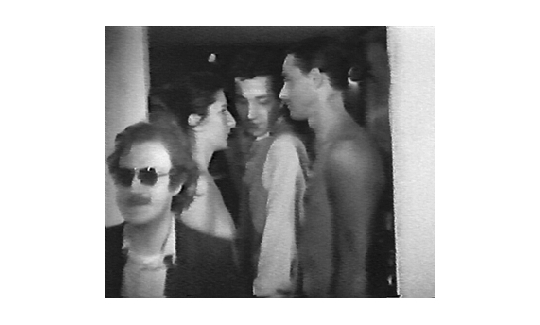Marina Abramovic and her partner Ulay* represent a performative approach that was extremely influential during the 1970s. They examined the threshold of pain and the limits of physical endurance, which at times entailed putting the viewer in uncomfortable and embarrassing situations. These situations were meant to create a cathartic experience, while boldly redefining the boundaries between artist and viewer. In their performances, which were often acted out in the nude, the two always allowed for unexpected occurrences, which stemmed from their interaction with the audience in real time.
In the work, Imponderabilia (1977), Abramovic and Ulay faced one another, naked, between two pillars at the main entrance to a museum in Bologna, Italy. Museum visitors were thus forced to pass through the narrow space between the two. The choice visitors made as to which of the two artists they would have to brush against was the main point of interest for Abramovic and Ulay. The performance, which was captured on secret camera, was ended by the police approximately an hour and a half after it began (not before the policemen intentionally brushed against Abramovic, according to her testimony, and asked for identity cards, which the artists were obviously not carrying). The range of audience responses - embarrassed laughter, sexual excitement or aversion - were an integral part of the work, which also attempted to undermine the conservative, sterile quality of exhibition spaces.
This work is exhibited as part of the exhibition "Live Acts - Performing the Body."
Marina Abramovic was born in Yugoslavia, 1946; lives and works in Amsterdam and New York; Ulay was born in Germany, 1943; lives and works in Netherlands
*Ulay is the performance name of the German artist Uwe Laysiepen
These changes have also resonated in the field of art making, where they are given expression through an intensive preoccupation with emotions. The desire to give visual expression, and sometimes even physical texture, to a range of emotions is what weaves together the different narrative threads of which "Mixed Emotions" is composed. The preoccupation with emotions raises challenging questions about representation and interpretation: is it at all possible to represent emotions and mental states? Are works about emotions necessarily emotional? Do conceptual approaches contradict the preoccupation with emotion? Is it possible to separate emotion from authenticity?
The richness and complexity of emotional expressions in art touches upon every domain of life - from the most intimate to the social and political. The thematic structure of the exhibition, which reflects this complexity, is divided into five parts: Emotion/Language, which reflects the manner in which words become carriers of emotion; The Body Language of Emotion, which reflects the physical, externalized manifestations of emotion; Adolescent Angst and Romantic Love, which reflects contemporary values from a mostly critical, doubtful stance; Emotions in Familial and Parental Relationships, which points to the intimate and complex expression of emotions in relationships; and finally, Collective Emotions in Israeli Political Reality, which reflect the emotionally intense nature of ideological beliefs and charged events.
It seems that even if the works in the exhibition sometimes express "calculated," artificial emotions, which are amplified and consciously made to fit certain representational conventions - at times refuting the very ability to feel and express "authentic" emotions - it nevertheless seems that they have the power to awaken in us intense emotions and real experiences.

